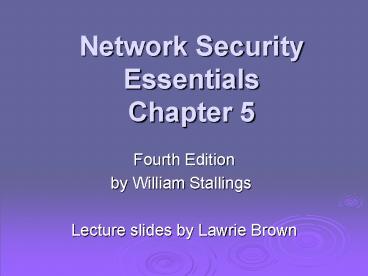Network Security Essentials Chapter 5 - PowerPoint PPT Presentation
1 / 25
Title:
Network Security Essentials Chapter 5
Description:
Title: William Stallings, Cryptography and Network Security 5/e Subject: Lecture Overheads - Ch 16 Author: Dr Lawrie Brown Last modified by: William Stallings – PowerPoint PPT presentation
Number of Views:162
Avg rating:3.0/5.0
Title: Network Security Essentials Chapter 5
1
Network Security EssentialsChapter 5
- Fourth Edition
- by William Stallings
- Lecture slides by Lawrie Brown
2
Chapter 5 Transport-Level Security
- Use your mentality
- Wake up to reality
- From the song, "I've Got You under My Skin by
Cole Porter
3
Web Security
- Web now widely used by business, government,
individuals - but Internet Web are vulnerable
- have a variety of threats
- integrity
- confidentiality
- denial of service
- authentication
- need added security mechanisms
4
Web Traffic Security Approaches
5
SSL (Secure Socket Layer)
- transport layer security service
- originally developed by Netscape
- version 3 designed with public input
- subsequently became Internet standard known as
TLS (Transport Layer Security) - uses TCP to provide a reliable end-to-end service
- SSL has two layers of protocols
6
SSL Architecture
7
SSL Architecture
- SSL connection
- a transient, peer-to-peer, communications link
- associated with 1 SSL session
- SSL session
- an association between client server
- created by the Handshake Protocol
- define a set of cryptographic parameters
- may be shared by multiple SSL connections
8
SSL Record Protocol Services
- confidentiality
- using symmetric encryption with a shared secret
key defined by Handshake Protocol - AES, IDEA, RC2-40, DES-40, DES, 3DES, Fortezza,
RC4-40, RC4-128 - message is compressed before encryption
- message integrity
- using a MAC with shared secret key
- similar to HMAC but with different padding
9
SSL Record Protocol Operation
10
SSL Change Cipher Spec Protocol
- one of 3 SSL specific protocols which use the SSL
Record protocol - a single message
- causes pending state to become current
- hence updating the cipher suite in use
11
SSL Alert Protocol
- conveys SSL-related alerts to peer entity
- severity
- warning or fatal
- specific alert
- fatal unexpected message, bad record mac,
decompression failure, handshake failure, illegal
parameter - warning close notify, no certificate, bad
certificate, unsupported certificate, certificate
revoked, certificate expired, certificate unknown - compressed encrypted like all SSL data
12
SSL Handshake Protocol
- allows server client to
- authenticate each other
- to negotiate encryption MAC algorithms
- to negotiate cryptographic keys to be used
- comprises a series of messages in phases
- Establish Security Capabilities
- Server Authentication and Key Exchange
- Client Authentication and Key Exchange
- Finish
13
SSL Handshake Protocol
14
Cryptographic Computations
- master secret creation
- a one-time 48-byte value
- generated using secure key exchange (RSA /
Diffie-Hellman) and then hashing info - generation of cryptographic parameters
- client write MAC secret, a server write MAC
secret, a client write key, a server write key, a
client write IV, and a server write IV - generated by hashing master secret
15
TLS (Transport Layer Security)
- IETF standard RFC 2246 similar to SSLv3
- with minor differences
- in record format version number
- uses HMAC for MAC
- a pseudo-random function expands secrets
- based on HMAC using SHA-1 or MD5
- has additional alert codes
- some changes in supported ciphers
- changes in certificate types negotiations
- changes in crypto computations padding
16
HTTPS
- HTTPS (HTTP over SSL)
- combination of HTTP SSL/TLS to secure
communications between browser server - documented in RFC2818
- no fundamental change using either SSL or TLS
- use https// URL rather than http//
- and port 443 rather than 80
- encrypts
- URL, document contents, form data, cookies, HTTP
headers
17
HTTPS Use
- connection initiation
- TLS handshake then HTTP request(s)
- connection closure
- have Connection close in HTTP record
- TLS level exchange close_notify alerts
- can then close TCP connection
- must handle TCP close before alert exchange sent
or completed
18
Secure Shell (SSH)
- protocol for secure network communications
- designed to be simple inexpensive
- SSH1 provided secure remote logon facility
- replace TELNET other insecure schemes
- also has more general client/server capability
- SSH2 fixes a number of security flaws
- documented in RFCs 4250 through 4254
- SSH clients servers are widely available
- method of choice for remote login/ X tunnels
19
SSH Protocol Stack
20
SSH Transport Layer Protocol
- server authentication occurs at transport layer,
based on server/host key pair(s) - server authentication requires clients to know
host keys in advance - packet exchange
- establish TCP connection
- can then exchange data
- identification string exchange, algorithm
negotiation, key exchange, end of key exchange,
service request - using specified packet format
21
SSH User Authentication Protocol
- authenticates client to server
- three message types
- SSH_MSG_USERAUTH_REQUEST
- SSH_MSG_USERAUTH_FAILURE
- SSH_MSG_USERAUTH_SUCCESS
- authentication methods used
- public-key, password, host-based
22
SSH Connection Protocol
- runs on SSH Transport Layer Protocol
- assumes secure authentication connection
- used for multiple logical channels
- SSH communications use separate channels
- either side can open with unique id number
- flow controlled
- have three stages
- opening a channel, data transfer, closing a
channel - four types
- session, x11, forwarded-tcpip, direct-tcpip.
23
SSH Connection Protocol Exchange
24
Port Forwarding
- convert insecure TCP connection into a secure SSH
connection - SSH Transport Layer Protocol establishes a TCP
connection between SSH client server - client traffic redirected to local SSH, travels
via tunnel, then remote SSH delivers to server - supports two types of port forwarding
- local forwarding hijacks selected traffic
- remote forwarding client acts for server
25
Summary
- have considered
- need for web security
- SSL/TLS transport layer security protocols
- HTTPS
- secure shell (SSH)































